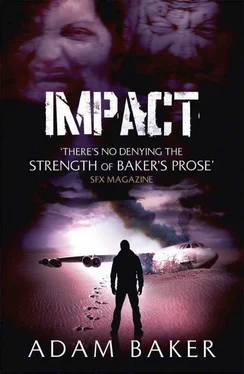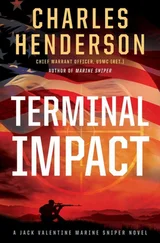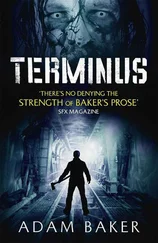He typed:
PLEASE IDENTIFY YOURSELF
He waited a long while. No response.
PLEASE VERIFY AUTHORITY
DESIGNATED COMSEC PROTOCOL
AS PER MISSION SPEC
No reply.
He typed:
WHO AM I TALKING TO
Incoming:
ABSOLUTE PRIORITY
CONVEY WARHEAD TO TARGET SITE
INITIATE PACKAGE
ACKNOWLEDGE
ACKNOWLEDGE
ACKNOWLEDGE
ACKNOWLEDGE
ACKNOWLEDGE
The screen continued to scroll Acknowledge until he hit Break.
He thought a long while, then typed:
MESSAGE RECEIVED
CONFIRM COMMAND
PROCEED TO DESIGNATED MARKER AND
TRIGGER DEVICE
Frost watched, mesmerised, as heat rippled from the upper surfaces of the starboard wing. Hallucinatory haze turned the wide expanse of metal to a shimmering, insubstantial thing so ghostly she felt, if she were to reach out to touch the steel and aluminium structure, her fingers would pass through it as if it were smoke.
The sandstorm had shielded the crash site from the morning sun. But now there was no respite. Searing, blistering light.
Better cover as much skin as possible. She zipped her flight suit, pulled on gloves and turned up her collar.
Hancock emerged from the plane. He dug beside the nose.
‘What’s he after?’ asked Noble.
‘No idea.’
They watched him work.
‘Need any help?’
Hancock ignored them.
Frost sat in the pilot seat. She lifted a blast screen. The vast dunescape. Barren mountains veiled by heat haze.
From her position in the cockpit she could look down on Hancock as he worked outside. He was digging in the sand, excavating something buried by the storm.
The sled. Deck plate lashed with a cable tow rope. The chunk of grate he used to drag the battery from the tail section. He gripped the cable and hauled it clear of the sand.
Noble climbed the ladder to the flight deck. He stood beside Frost and looked out the window.
‘Think he’s lost it?’
‘Hard to say.’
They watched Hancock pull a long length of injector pipe from the sand. He shook out the dust-matted flag and tied it to the pole.
He stabbed the pole into the ground. The flag hung limp.
Inverted stars and stripes. A futile signal of distress.
The crawlway.
A tight, steel-sided tunnel, little wider than an air duct.
Hancock on his hands and knees. He held a flashlight between his teeth like a cigar. He pushed the backpack ahead of him. He dragged the satcom unit behind.
The bomb bay pressure door. A heavy hatch secured by crank handles.
He turned the handles. The door wouldn’t open. The frame had distorted during the crash. He curled foetal, turned in the tight crawlspace and kicked at the door with booted feet. Metal shriek. The door swung open.
Stifling darkness.
He crawled inside and stood upright. A wall-mounted toggled switch. He flicked On. Immediate crack and spark-shower from cabling above his head. He flinched from the sparks and flicked Off. He traced cable with the beam of his flashlight until he found a frayed break in the line. He stripped and twisted copper wire.
He flicked the switch again.
Secondary lights burned steady. The compartment lit blood red.
He surveyed the vaulted weapons bay.
Dead power cable and data lines hung from roof conduits like jungle vine. He ducked beneath them.
His boots crunched sand. The payload doors had been ripped away, leaving a wide aperture in the floor open to the desert.
The centre of the bay was dominated by a rotary launcher: a drum-rack that could house at max five ALCMs and position them, one by one, above the open payload doors ready for deployment.
An eighteen-foot Tomahawk missile held by clamps. Solid-propellant power plant and intakes at the rear. TERCOM terrain mapping radome in the nose.
The warhead was housed in the payload section behind the nose. A Mod 4 CS-67 tactical nuke prepped for a ten kiloton yield.
He ran his hand over the surface of the weapon. White lacquer, like bathroom porcelain. The missile appeared undamaged.
He took a compact Geiger counter from his pocket. He took a reading, passed the sensor the length of the bomb. Steady background.
He unzipped his backpack and pulled out a flat Peli trunk the size of an attaché case. He flipped clasps and opened the trunk.
A laptop bedded in foam. Beside it: tools, cables, replacement fuses. Battlefield triage. Everything he would need to monitor and maintain the missile up to the moment it was jettisoned from the plane.
Titanium torque keys. He selected a key, lifted it from its foam trough and set to work.
The payload compartment of the ALCM was studded with twenty-four hex screws. A laborious task to release each screw. He had to crouch beneath the weapon with a flashlight. Had to pause every couple of minutes to shake fatigue from his fingers.
The final bolt. He set it turning, threw the wrench aside, and unscrewed by hand.
A faint click as the bolt cleared the thread. The cowling dropped loose. He carefully lifted the panel clear. It was heavy. Hardened steel alloy.
The core. An anti-radiation jacket held in a titanium frame. A featureless cylinder wired to a bundle of fusing and firing circuits. Uranium 235 hemispheres, plutonium 239 and a tritium/deuterium booster, all of it jacketed with hexagonal plates of high explosive to force a millisecond of super-compression.
Critical mass. Cascading fission. Stellar light. Nova heat.
Arming the warhead for manual detonation would take all the cold-sweat delicacy associated with defusing an IED. The slightest error would transform the weapon into a giant paperweight.
A nine-pin data port bedded in the surface of the confinement case.
He placed the laptop on the sand floor of the bomb bay. Flickering boot sequence. He ran cable and jacked into the warhead.
A winking cursor.
A black plastic tag hung round his neck on a lanyard. He lifted the lanyard over his head, snapped the tag in two and removed a small slip of paper.
He unfolded the paper and typed the ten digit authenticator code:

The code input field was immediately replaced by a status screen. The arming sequence and fuse system. The heartbeat of the weapon.

Permissive Action Links.
A five-stage authorisation protocol which would enable the bomb. Unless the weapon were activated in sequence a series of barometric, impact, and rate-of descent lock-outs would render the warhead inert to prevent accidental detonation. It could be consumed by fire or dropped thousands of feet with no chance of triggering thermonuclear reaction. It could only be detonated by specific human intent.
Four of the PAL cut-outs flashed green. Final authorisation flashed red.
The B-52 crashed on target approach, just before it reached the hold coordinates, the point at which Hancock would have checked in with USSTRATCOM and requested go/no-go authorisation. Once the order had been received, Frost would have armed the warhead and directed Noble to jettison the missile.
A deliberately fragmented protocol that would ensure a lone individual couldn’t launch a nuke on a whim.

A single ten-digit code would complete the arming sequence and render the warhead live.
Читать дальше















